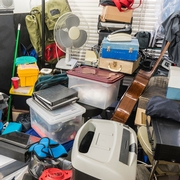Information you need to live a happy, worry-free retirement!
How Decluttering Might Keep You Healthy as You Age

Everyone has clutter, but it’s especially important to keep it in check as we age. Decluttering your home can improve not only your physical wellbeing but also your mental health.
If you’re looking for some motivation to tackle that clutter, read on to discover the risks that clutter can pose to your health and get some tips to tackle it once and for all.
Declutter to Reduce Fall Risks
A cluttered home can limit mobility and cause falls. Falls are the single largest cause of death and injuries in older Americans. Every 20 minutes, an older adult dies from a fall, according to the Centers for Disease Control and Prevention (CDC). For that reason alone, removing clutter is a vital safety move.
Identify and remove any trip hazards, which may include throw rugs. If you have electrical cords, consider taping them to the floor. Remove any furniture or large items you don’t need so that you have more space to maneuver and fewer chances of falling and getting stuck.
Fire Hazards
Because loss of mobility is common in older adults, it’s especially important to make sure that your home is clear of clutter in case of an emergency such as a fire. Compounding the fire risk is the likelihood that older adults have reduced sensory ability, meaning their reaction times may be slower. Decluttering a home can improve your chances of escaping if a fire were to occur. When decluttering, ensure all doorways, hallways and stairs are clear of furniture and other items that could become an obstruction or tripping hazard during a fire emergency.
Dust Mites, Rodents and Bugs
Too much clutter usually leads to reduced cleaning, which can worsen allergies and breathing problems. Mold — which can cause headaches, nausea and more — can lurk in areas covered in clutter where moisture and low air circulation can create a breeding ground. Chronic exposure to dust mites can cause allergies and asthma, according to the American Lung Association.
Rotting food can attract rodents and bugs, which can introduce disease risks into the home. The Hantavirus, carried by some mice, can be transmitted to humans when rodent waste is stirred up and breathed in, leading to a potentially fatal respiratory disease. Flies and cockroaches can carry the salmonella bacteria among other illness-inducing diseases.
Tips to Tackling Clutter
Many different strategies exist to declutter. The most common approach is to sort items into four boxes: save, donate/sell, recycle and trash.
But for many people, that advice doesn’t address the emotional difficulties associated with decluttering.
Professional organizer, Peter Walsh, author of “Let It Go,” gives this advice to let go of emotional clutter: realize that if you let go of an item, you do not let go of that person; hold on to items that bring back positive memories, not painful ones; and make sure your space has a great representation of the past but also leaves room for you to celebrate the present and plan for the future.
He suggests categorizing items into three categories: memory items, I-might-need-it items and trash/recycling. Then use this “Let It Go” flowchart to guide you.
Declutter when you’re in a good frame of mind, and limit each session to no more than three hours. Because it can be tiring emotionally and physically, avoid exhausting yourself each go-round. Like any big project, breaking it into smaller sessions makes it easier to both start — it seems less daunting — and ultimately to accomplish.
The key is to start small, such as by tackling one room, one bookshelf or even one drawer at a time, said Cindy Glovinsky, MSW, a psychotherapist and professional organizer who wrote “Making Peace with the Things in Your Life.”
"As people clean up, their energy seems to rise," Glovinsky said. And "once clutter is cleaned up, some people begin to work on other issues."
In fact, if you don’t work on those “other issues,” you might end up back in clutterville. Work on the lifestyle or habits that got you there. Are you a procrastinator? Or are you over-consuming, buying items out of boredom or to fill an emotional void? Don’t just buy organizing bins only to let items pile up around them. Remember that decluttering is ongoing process. It might even help to schedule time on your calendar to tackle the clutter.
You also might need to ask for help. A professional organizer can pave the way for changing habits by teaching you tricks and tips you might never have thought of. Sometimes, clutter problems need a different kind of help, however.
When Clutter Becomes Hoarding
Hoarding disorder is more common among older adults — three times as many adults age 55 to 94 years are affected by hoarding disorder compared to adults 34 to 44 years old. Characterized by excessively saving items that others may view as worthless, hoarding disorder leads to clutter that disrupts their ability to use their living or work spaces.
If you or someone you know needs help, search the International OCD Foundation’s resource directory for therapists, clinics, treatment programs, support groups and organizations specializing in hording disorder in your area.



